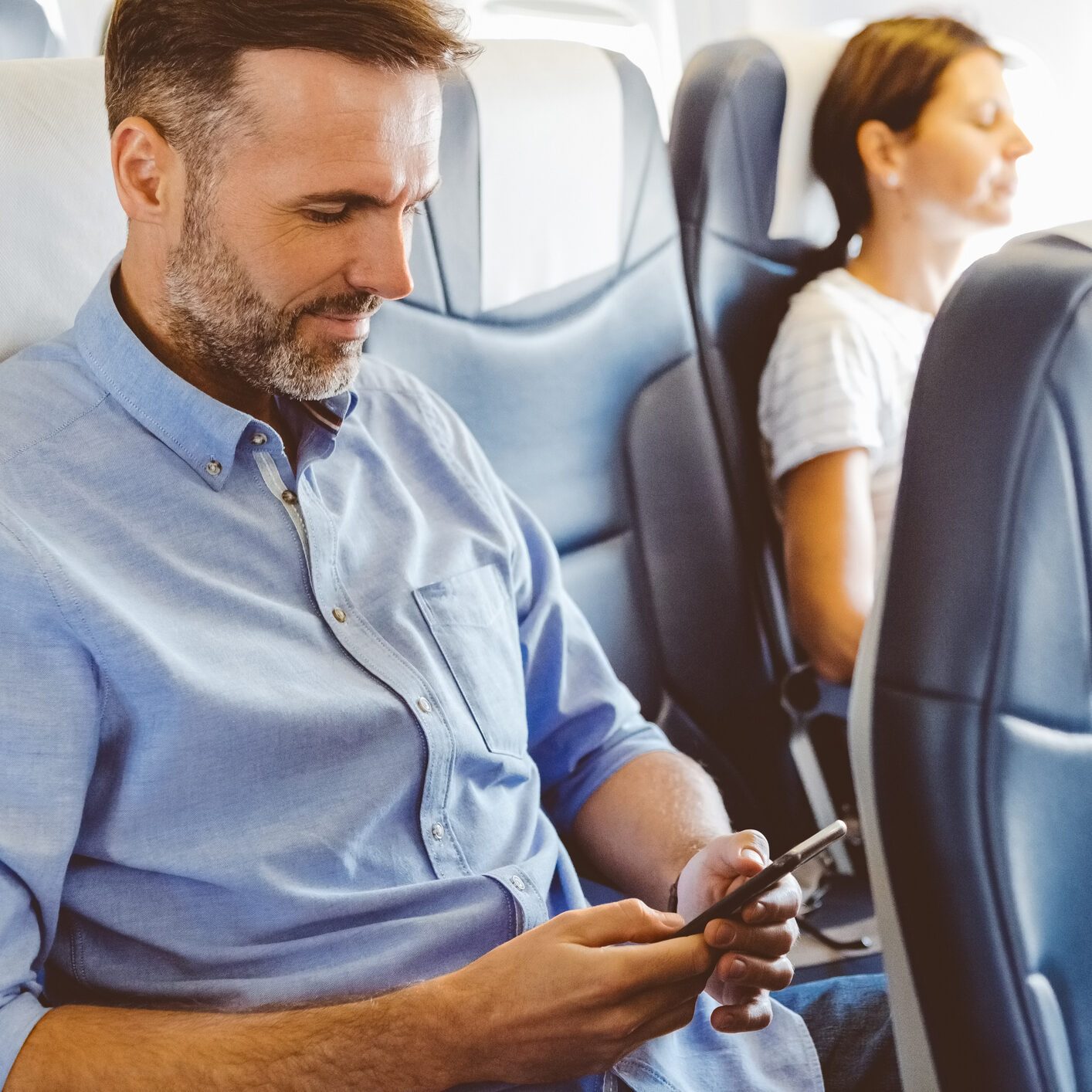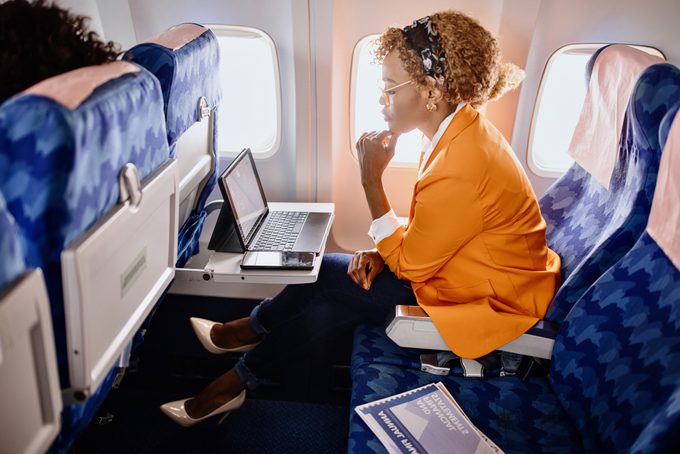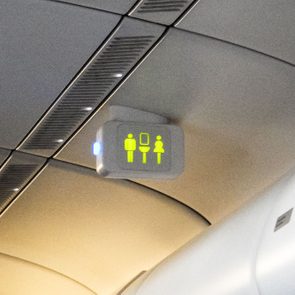No, you can't just crown yourself king of the middle seat. Follow these essential etiquette rules to keep peace with your neighbor.

Sitting Next to an Empty Middle Seat On an Airplane? Here’s What Not to Do

Sitting next to an empty middle seat is like winning the airplane lottery—your spot quickly becomes the best seat on the plane. (Heck yes, free side table!) I’ve landed this perk just once, and it was only because my travel companion was a toddler who wanted to be held by Dad, in the row behind us. Was I a little offended that I wasn’t the Chosen Parent? Maybe. But any negative emotions were immediately outweighed by the sheer bliss of getting an entire extra empty seat all to myself. I laid on top of my diaper bag and promptly fell asleep.
But was the middle seat really all mine? Technically, yes. We’d paid for the seat for my son, after all.
Unofficially, an “empty middle seat is considered fair game for the passenger on either side of it, and it doesn’t really matter why it’s empty,” says Cecily Anderson, a flight attendant with a major U.S. airline. However, that doesn’t mean its use is always fair. “I’ve seen ‘fair game’ turn into the Hunger Games over those seats—so many fights.”
Fighting is obviously the wrong response to this gift from the airline gods. “If you are lucky enough to end up with extra space on a plane, it’s polite to at least offer to share it,” says Jan Goss, an etiquette expert with more than 30 years of experience in topics ranging from business to airplane etiquette. “My motto is to always lead with empathy. What is the kind thing to do in this situation?”
Ahead, Anderson and Goss explain what you should (and shouldn’t!) do if you’re lucky enough to land a seat next to an empty middle seat.
Get Reader’s Digest’s Read Up newsletter for more etiquette, travel, tech, cleaning, humor and fun facts all week long.
What shouldn’t you do when you’re sitting next to an empty middle seat?
For the lucky ducks sitting next to an empty middle seat, etiquette boils down to a maxim even kindergarteners understand: Sharing is caring. In other words, you shouldn’t get selfish with the free space.
People in this seating situation tend to make one of two major etiquette mistakes:
- Mistake No. 1: Assuming you’re entitled to the empty middle seat. “Even if you got there first and put your stuff on it, it doesn’t mean it’s yours for the whole flight,” Anderson says.
- Mistake No. 2: Treating the empty seat like your personal living room. The temptation to spread out is strong, but a polite traveler resists the urge to plop their jacket in the middle seat, toss their bag under it, put their snacks on the tray table and otherwise mark their territory as if they are staking a claim on the Oregon Trail.
The empty seat is neutral ground, not your new empire, and you should respect the peace treaty. “You should avoid doing anything that encroaches on the other person’s space,” Goss says.
But how do you know what’s your space vs. theirs? “Good communication is the key,” she says. “Just ask them if they mind if you put your things down. And offer them some of the space as well.”

What are the unwritten rules for sitting next to an empty middle seat?
These rules may not be in the in-flight safety pamphlet, but they’re just as vital to ensuring a safe and happy voyage at 35,000 feet. Follow them, and you’ll not only enjoy your extra space but may also make a new friend—and possibly get a nod of approval from the flight attendant, Anderson says. “People often expect other passengers to be rude, so these little acts of kindness can really go a long way,” she says.
Share the middle tray, especially for beverage service
When the beverage cart comes your way (or your elbow’s way), remember that the middle tray is not your personal minibar. Offer to place both drinks on the empty tray so each of you can enjoy your snacks on the tray in front of you.
Ask before having someone else sit there
Got a buddy in another row eyeing that empty seat? Ask your row neighbor before summoning them over, Goss says. If it’s empty because your traveling companion vacated it, as in my situation, it’s fine to fill it with a different traveling companion. But if it’s empty by chance, then follow airplane etiquette and check in with the other person sitting in that row.
Keep your feet to yourself
The gross things that people do with their feet on airplanes could fill a book, but for the sake of this, article know this: The empty seat does not mean you’ve won a footrest. Under no circumstances should your shoes (or, heaven forbid, bare feet) creep over to that middle territory. Feet are never a good surprise.
You can, however, manspread a bit—allowing your legs to spread wider than you usually would on a plane—as long as you don’t touch your neighbor.
Maintain elbow equality
With no one in the middle, the armrest situation can be fairly straightforward: You get one, and your row neighbor gets the other. The armrests provide a natural barrier. “Just be careful when lifting up your armrest that you’re not getting into their personal space,” Anderson says.
Use headphones and contain your tech
Thinking of spreading out your tech and setting up your laptop for a movie marathon? The light, noise, cords and space encroachment can make the other person uncomfortable.
“Ask before setting up your laptop on that seat,” Goss says, “and always use headphones on an airplane.” If the other person would like a turn, then compromise about sharing the time or space, she adds.
Share the extra charging ports
Charging your phone at your seat while charging your laptop next to you? Dream come true! Just ask before monopolizing all of the chargers, and work out a fair custody agreement if they’d like a turn as well, Goss says.
Be careful about how you lay down
If you’d like a nap, it’s OK to use half of the extra seat to get comfy (or the whole seat if your neighbor agrees), but be mindful of how you relax. It’s the classic dilemma: Do you aim your butt or your head at stranger? “Ideally, you stay sort of seated and slump to the side away from the stranger,” Anderson says. “But I’ve seen every configuration, including someone laying their head on a stranger’s lap. That didn’t go well.”
There aren’t any perfect options for using the middle seat to sleep on a plane, so just do your best to avoid touching your neighbor or putting anything smelly (like your feet) in their vicinity.
Don’t put your trash on the middle seat
It’s so tempting to keep your space clear by stacking trash on the middle seat, but that is gross and can frustrate your neighbor. “Put your trash in the trash bag,” Anderson says.
Follow all the safety rules
“You’re not allowed to hold your bag on your lap during takeoff and landing or turbulence because it can become a projectile, and the same is true for placing things on the middle seat,” Anderson says. It doesn’t have magic properties, and you still need to follow all the airplane safety instructions as directed.
And remember, at the end of the day, the empty middle seat “is a gift, not a right,” Goss says. Treat it with reverence, and the universe may reward you with another one on your return flight. Safe (and spacious) travels!
About the experts
|
Why trust us
Reader’s Digest has published hundreds of etiquette stories that help readers navigate communication in a changing world. We regularly cover topics such as the best messages to send for any occasion, polite habits that aren’t as polite as they seem, email and texting etiquette, business etiquette, tipping etiquette, travel etiquette and more. We’re committed to producing high-quality content by writers with expertise and experience in their field in consultation with relevant, qualified experts. We rely on reputable primary sources, including government and professional organizations and academic institutions as well as our writers’ personal experiences where appropriate. For this piece on airplane etiquette, Charlotte Hilton Andersen tapped her experience as a longtime journalist who specializes in etiquette and communication for Reader’s Digest. Read more about our team, our contributors and our editorial policies.
Sources:
- Cecily Anderson, flight attendant with a major U.S. airline; in-person interview, Jan. 2, 2025
- Jan Goss, etiquette expert, CEO and founder of Show Up Well consulting and author of Protocol Power; phone interview, Jan. 4, 2025























